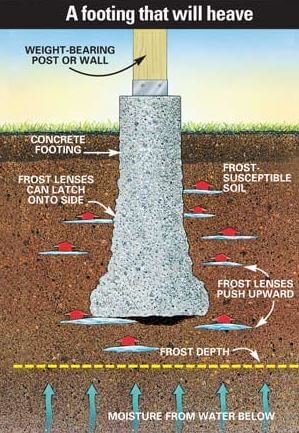INTRODUCTIONThe main purpose foundations serve is to distribute and resist the forces or loads experienced by the host structure due to wind, rain, snow, seismic, & other load conditions. When it comes to building components such as generators, signs, and fences the code leaves a gray area for foundation design. This happens because most building components are non-habitable by and therefore aren’t at the forefront of thought when code requirements are established. This article summarizes our research regarding which footing situations steel reinforcement is not needed when designing building components and provides some alternate reinforcing methods for design.
TO REBAR OR NOT TO REBAR? The ACI 318-14 manual is the leading standard when it comes to concrete design. Chapter 2 of ACI 318-14 gives us the definition for plain concrete: “concrete, plain—concrete with no reinforcement or with reinforcement less than the minimum amount specified for reinforced concrete.” As mentioned, the definition of plain concrete doesn’t necessarily mean it doesn’t have any rebar present, it just means it has less rebar than specified amount for its selected use. For the purposes of this article we will assume that plain concrete lacks any and all reinforcement. Continuing to Chapter 14 of ACI 318-14 we finally get a scope of us for “plain concrete” and what are some cases in which plain concrete is permitted: · “14.1 – Scope This chapter shall apply to the design of plain concrete members, including (a) and (b): (a) Members in building structures (b) Members in non-building structures such as arches, underground utility structures, gravity walls, and shielding walls” · “14.1.3 – Plain concrete shall be permitted only in cases (a) through (d): (a) Members that are continuously supported by soil or supported by other structural members capable of providing continuous vertical support (b) Members for which arch action provides compression under all conditions of loading (c) Walls (d) Pedestals”
· “14.1.4 Plain concrete shall be permitted for a structure assigned to Seismic Design Category (SDC) D, E, or F, only in cases (a) and (b): (a) Footings supporting cast-in-place reinforced concrete or reinforced masonry walls, provided the footings are reinforced longitudinally with at least two continuous reinforcing bars. Bars shall be at least No. 4 and have a total area of not less than 0.002 times the gross cross sectional area of the footing. Continuity of reinforcement shall be provided at corners and intersections. (b) Foundation elements (i) through (iii) for detached one and two-family dwellings not exceeding three stories and constructed with stud bearing walls: (i) Footings supporting walls (ii) Isolated footings supporting columns or pedestals (iii) Foundation or basement walls not less than 7-1/2 in. thick and retaining no more than 4 ft of unbalanced fill.”
Reading through the permitted cases for non-reinforced concrete, the bolded ones are the ones that apply the most to building components. Beginning with the broadest case; “14.1–Scope: …(b)”, this case covers most building components, only being limited on a case specific basis. ACI 318-14 then continues to give us other situations in which plain concrete is permitted IS “14.1.3-(a)“. These definitions can be applied to many building components such as sunshades, overhangs, exterior building decorations attached to the building (for aesthetic purposes), posts, etc. Also, it lays the framework for isolated footings not related to family dwellings or any habitable spaces, the phrase that covers this is “(a) Members that are continuously supported by soil…”. So in accordance with ACI, if the footing is continuously supported by soil it is okay to be designed as plain concrete, more on this topic later in the article. The last applicable allowable case specified by ACI is “14.1.4-… (b)”. This case can be applied to any footings used to for large or small fences, canopies, generators, or any other non-building structures that may need footings. Commentary provided on this section gives us the reason on why plain concrete is allowable in such limited cases. To summarize the commentary since the capacity of plain concrete is directly correlated to the compressive strength, size, and other properties plain concrete should be reserved only for uses in which the concrete will primarily be: in compression, needed to tolerate random cracks without detriment to its structural soundness, and is expected to have low ductility since it is not an essential design feature.
Overall, you must calculate the worst load combination experienced by the proposed member. ASCE 7 gives us our basic load combinations which also correspond to Florida Building Code Seventy Edition (2020) Section 1605.3. The concrete foundation must have the capacity to handle the axial, self-weight, uplift and sliding forces & the overturning moments by a factor of safety of 1.5,I f the worst load combination is not 0.6W + 0.6D. If the worst load combination is 0.6W + 0.6D then the concrete foundation must handle the before mentioned forces by a factor of safety of 1.67. Keep in mind this is only applicable if wind is your governing load case, if not this factor of safety is subject to change in accordance with the governing load. The foundation must also meet the criteria in ACI 318-14 sections 14.1, 14.1.3, and the seismic category that the slab falls within the categories mentioned in section 14.1.4. If you believe your slab will take high shear forces due to temperature or shrinkage fiber reinforcement is recommended, or if the footing will experience any high-tension loads rebar is recommended. This should be checked by the EOR or designer.
CONCRETE POST FOUNDATIONS Quick note regarding plain concrete post footings and their limitations. Per International building code (2018), if a footing is geographically located in an area where the frost line is zero inches a patio cover shall be permitted to be supported on a concrete slab, on grade without footings, provided that the slab follows provisions in Chapter 19 of International Building Code (2018) and that the slab is not less than 3.5 inches thick. The columns may not support loads in excess of 750 pounds (3.36kN) per column.
FIBER-REINFORCED CONCRETE This leads us into our next section, what is fiber reinforced concrete (FRC)? ACI defines it in their ACI318-14 manual as mainly concrete reinforced with steel fibers, but Fiber reinforced concrete (FRC) is concrete containing fibrous material which increases its structural integrity. Fibers are usually short, discrete, and are uniformly distributed and randomly oriented. Fiber material may vary from steel to glass, and even synthetic or natural fibers. ACI318-14 covers this in CH 7. Table 7.6.1.1 gives us a minimum required area of steel or “wire-reinforcement” for non-prestressed one slabs. As seen below it gives us a formula for reinforcement needed based on the gross cross-sectional area of the concrete slab and its yield strength. Why use FRC? Reinforcing concrete with fibers is less expensive than hand-tied rebar, while still increasing the tensile strength many times. The fibers can be circular or flat, and they are often described by a convenient parameter called “aspect ratio”. The aspect ratio is the ratio of its length to its diameter. Typical aspect ratio ranges from 30 to 150. The fibers help concrete in a very similar matter as rebar does. Since the modulus of elasticity of the fibers is higher than the concrete, they help support the forces experienced by the structural member by increasing the tensile strength of the member. Increasing the aspect ratio of the fibers usually leads to an increase in the flexural strength and toughness of the member, but if the fibers are too long, they can contract and create a “balling up” effect in the concrete mix and become workability problems. Fiber reinforcement has one more benefit that hasn’t been concluded yet and it is that it may improve concretes’ freeze thaw resistance. A fibermesh ratio of 0.1%/cuyd is typically seen in the industry for smaller building component applications. FRC & FORST/THAW RESISTANCE
There was a study conduct by Cantin and Pigeon, and Pigeon et al. The study concluded that the incorporation of steel fibers with a length between 54 mm – 60 mm (2 – 2.5 in.) do not have a significant influence on the concrete resistant to surface scaling. In contrast incorporating short fibers with a length of 3 mm reduced the amount of concrete degradation. Now while this study shows these results there are some other studies it references within that show the opposite. Overall this benefit, in our opinion for the time being, remains inconclusive. For more information regarding rebar requirements please visit ACI-360 & ASCE 7
Sources: https://www.asce.org/uploadedFiles/Newsroom/Content_Pieces/asce-fact-sheet.pdf https://alleghenydesign.com/fiber-reinforcing-in-concrete-slabs/ https://theconstructor.org/concrete/fiber-reinforced-concrete/150/ https://www.britannica.com/biography/Joseph-Monier https://www.giatecscientific.com/education/the-history-of-concrete/ https://csengineermag.com/article/clearing-the-confusion-on-plain-concrete/ https://engineeringexpress.com/wiki/frost-protection-concrete-footings-grade/ https://www.sciencedirect.com/science/article/pii/S1877705815013144 https://en.wikipedia.org/wiki/American_Concrete_Institute https://en.wikipedia.org/wiki/Fiber-reinforced_concrete
An article authored by Francisco Sarmiento of Engineering Express 5/2019 |
Last Update: February 19, 2022

 Section
Section